I have to confess that I find most veterinary lectures boring. But not the one at the German FN’s Bundeschampionate Seminar nearly ten years ago – it was amazing!
It was really an extraordinary presentation from the famed German equine veterinary expert, Professor Stadler. Here it was laid out, black and white, good training (that means correct, progressive, gymnastic training) is not ‘correct’ because this or that ‘expert’ thinks it is correct, it is correct because it promotes the physical welfare and long-term soundness of the horse…
It should have been obvious, but I had just never ever thought about it – vets have been crucial in the development of civilized training techniques, and not just famous modern vets like Gerd Heuschmann, but right through the Ages…
Not surprisingly, the Professor started with the Ancient Greek, Xenophon, pointing out that his essay had aimed to outline a training regime that inflicted ‘the least damage to the horse that is being used…”
He passed quickly over the Age of Chivalry, merely noting that at times the horses of the Medieval Knights looked a little like some of today’s dressage horses…
The professor pointed to some of the more extreme training methods of early ‘masters’ like Grisone and Newcastle, and suggested that the aggressive attitude to the horse was a result of the belief that horses were sentient beings and ‘the animal as an intelligent being is responsible for its actions and obstructiveness must be punished.’
more follows
The cruelties of the Baroque Age (1575 – 1770) were replaced by the civilized values of the Age of Enlightenment (1750 – 1780) where, led by the teachings of de la Guérinière, the horse came to be viewed as a graceful work of Art. Great value was placed on elegance, beauty, unconstrained movements and discrete aids.
more follows
François Robichon de la Guérinière published École de Cavalerie in 1733, a work that stressed three key points: 1 – Knowledge of the horse, 2 – Adequate training, stabling and grooming and 3 – Maintenance and promotion of health.
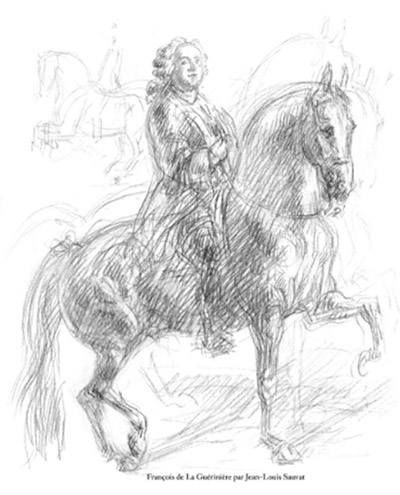
This new attitude went hand-in-hand with the establishment of the first schools of veterinary medicine: the University-Riding-Institute of Göttingen opened in 1734, followed by the Écoles Nationale Veterinaire of Lyon (1761) and d’Alfort (1765), then the Rossarzneischule Hannoer in 1778. Horses had become valuable so veterinary schools sprung up to keep them sound…
The nineteenth century saw contradictory threads. “The riding masters of the 19th century proposed very different approaches, from the very horse-friendly to positive torture.” (S. G. Solinski, Rider, riding, horse; The basics of the modern riding horse, 1993) Trainers like Baucher and Fillis used maximum flexion and absolute head elevation.
By the beginning of the twentieth century, this debate had crystallized in Otto de la Croix’s Natural Equestrianism (1901). He pointed to the extremes, Paul Pfinzner’s hyper-flexion and Fillis’ high elevation: “The time has seldom been more favorable for a detailed evaluation of the natural basics of the art of riding. Almost simultaneously we have hyperflexion and high elevation, and the riding world remains clueless who is right.”
It wasn’t just the vets who were trying to keep the horses healthy, the military also had a vested interest in their welfare, this led to the publication of the legendary Heeres-Dienst-Vorschrift or HDV 12, the Cavalry rulebook, published in 1912 which became the basis for the modern German training scale. When it was published the aim was more utilitarian: “Teaching riding must result in a reduction of temporarily unusable horses.”
The HDV 12 was revised in 1926 and 1937 by Hans v Heydebreck, Felix Bürkner and Richard Wätjen – all famous names in German equitation, all cavalry officers, all great dressage riders and trainers.
The goal was now: “By preserving and promoting its natural abilities, the horse will be brought into a shape and carriage that allows full development of his strength.”
Look at Bürkner riding, now we see the ‘classical (natural) style’ in action with an optimal, relative head elevation.
Also influential in refining the HDV 12 were a couple of influential vets: the anatomist at the Hannover Veterinary School, O. Zietchmann and a Veterinary Officer at the Cavalry School Hannover, Udo Bürger, the author of that classic, The Way to Perfect Horsemanship (1939).
What emerged was the scale that we all should know off by heart: cadence (rhythm), suppleness and rein contact – the 1st stage of training – and impulsion, straightness and collection, the 2nd (advanced) stage of training. The goal of all these principles is the maintenance of equine health.
This approach is enshrined in the 1997 FN resolution: “Dressage means gymnastic schooling and careful education of the horse to develop its natural talents, to improve its performance, to maintain its health and to achieve harmony between horse and rider.”
Professor Stadler showed a number of photos of horses illustrating their natural head carriage, and suggested that the:
Goal of classical training =
Body carriage with functional muscle tone:
With natural muscle tone at the correct level for the work load
And this involved:
Slow development of elevation or as Udo Bürger put it:
“Carriage will develop by itself as a consequence of schooling.”
However the schooling has to be correct schooling, and Professor Stadler pointed to the ‘modern’ riding style which he described as a ‘significant deviation from the natural head-neck carriage.’ This style of training led to a body carriage with dysfunctional muscle tone, which if practised for a long time leads to lameness. It also produces movement with the foreleg elevated, the back stiff, a protracted hindleg, and ‘dissociative movement’. Where, Professor Stadler asked was the FEI code of conduct, which stipulates… at all times the welfare of the horse must be paramount and must never be subordinated to competitive or commercial influences.’
The Professor went once again to Xenophon for an historical take on ‘clashing aids’:
“…if the rider holds the horse back with the rein and at the same time asks him to go forward, the horse will be irritated and will throw the chest forward and lift the legs higher because it is hot-tempered, not agile.”
Here we have the crucial connection between the psyche of the horse, the suppleness of its muscle tone, and resultant orthopedic health.
Jean-Marie Denoix and Jean-Pierre Pailloux in Physical Therapy and Massage for the Horse: Biomechanics – Exercise – Treatment point out that ‘emotional equilibrium is as important for optimum sporting performance as the physiological fitness of the anatomical structure’ – this is well-accepted for human athletes, but not always understood in relation to horses. Denoix and Pailloux establish that the pre-requisite for healthy forward movement is a favourable psychological environment, and that the cause of pathological orthopedic conditions are poorly coordinated movements that are executed too fast or slow. The causes of poorly coordinated movements can be diseases, limb disease, ataxia – and these are easy to see, the horse is lame.
Psychological stress results in dysfunctional muscle tone and tenseness. Because the horse is a flight animal, fear is expressed by contracting the muscles. The causes of dysfunctional tenseness can be environmental stress, or the demands of the rider, as when the horse is put in an inescapable aversive experience ‘jerk and spur’. Dysfunctional tenseness can also be caused by significant deviations from the natural body carriage. The function of the muscles in movement is contraction followed by elongation. If this process is incomplete, the muscle remains in contraction and the musculature hardens, this produces a wrong tension leading to poorly coordinated movements.
Is the goal of dressage an atonic [lacking muscle tone] horse? The professor asked, of course not. With the correct level of tension and the maintenance of an appropriate level of relaxation, then antagonistic muscles do not spasm, and the horse shows well coordinated movement, resulting in increased performance capacity. The alternative is a worn-out horse.
Suppleness of the individual muscles, muscle groups and the entire body, are a result of: education, repetition and training. Once this suppleness is learned it is always attainable. If it is not learned in the first month of training then it will not be achievable in the future. Suppleness is a psychological as well as physiological, or as Bürger put it: ‘innocence of mind must always precede suppleness of the body.’
The Professor was firm that the ‘modern riding style’ of working the young horse with tight head-neck carriage was the way to a tense horse and dysfunctional muscle tone. He suggested that as a result in modern times there were more examples of poor piaffe/passage than we saw with the Old Masters. But Professor Stadler was really at pains to show that the result was not only awful images and poor piaffe and passage, but also health problems.
This is no modern insight. La Guérinière in the eighteenth century asserted that ‘sadly even quite good horses can suffer bone and tendon injuries – impatient ‘trainers’ attempt to school them too quickly and destroy them.’ Again: ‘Strength and natural perfection are lost and disappear through over-working and exhaustion with too strenuous and prolonged exercise. The horse will develop joint and tendon sheath swelling, spavin and other diseases.’
Of more recent times, Professor Stadler pointed to the article in The Veterinary Journal (April, 2010), Identification of risk factors in dressage horses by Rachel Murray. The study found that lameness was the most common disease or injury in the dressage horse and that elite horses tended to be off work longer. The work indicated that 24% (557 out of the 2532 in the study) of dressage horses may become lame in a two year period. The most frequent problem was suspensory ligament and tarsal joint diseases, while 20% of dressage horses suffered from back pain.
Another paper, Identification of risk factors for lameness in dressage horses (Murray, R.C., Walters, J.M., Snart, H., Dyson, S.J. and Parkin, T.D.H. 2010) found: ‘It has been noted that extravagant moving young horses prepared for sale or young horse classes have a high incidence of hind proximal suspensory desmitis.’
In a paper in 2006, Rachel Murray noted: ‘During the stance phase of the stride, the hind limb is loaded, with the tarsal joint in flexion and metatarsophalangeal joint (MTPJ) in extension, resulting in loading of the suspensory ligament.’
In the mid stance of the extended trot, if the movement is not correctly supported by the horse’s back, then the suspensory ligament is loaded, but the same problem can also occur in the collected movements, As Udo Bürger noted: ‘premature exercise in piaffe and passage-like steps without suppleness, results in pathological changes in the suspensory ligament.’
Despite the views of some that the classical principles were hopelessly outdated and super-ceded by the ‘modern’ techniques, the professor showed that they were more needed than ever. In fact, the cavalry horses, schooled often by less-than-expert riders, lasted longer than the modern dressage horse! Cavalry horses in times of peace on average lasted in service until they were 15 years of age, and then went on to an additional 3 years of civil duty. In other words, they were sound and useful up to the age of 18. Modern Warmblood horses studied between 1974 and 1982 and 1986 and 1996, had an average working life of 8 to 10 years.
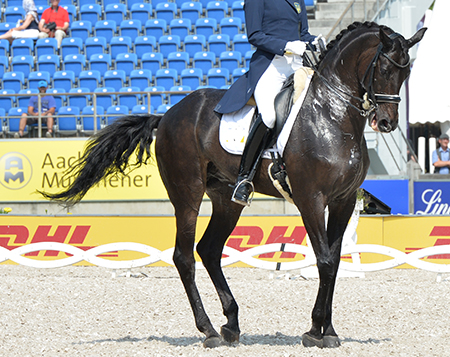
Bad Piaffe
The Cavalry Report of 1929 found that out of 37,000 horses, there was a wastage of 436 or 1.18% of the total, while Orthopedic disease affected 32 or 7% of that group, and that the horses had a mean age of 10.2 years. On the other hand, Sedensticker, (1999: Abgangsursachen entschädigter Pferde einer Tierversicherung aus den Jahren 1990-1995. Diss. med. vet., Tierärztliche Hochschule Hannover) looked at 30,000 horses between 1990 and 1995 and found a wastage of 519 horses (1.73%) and of that group an enormous 233 – or 45%! – suffered from Orthopedic disease. The modern horses had a mean age of 8.7 years.
And yet the solution to this modern wastage is there in the training program:
Cadence, rhythm > well coordinated movements
Suppleness > optimal economical muscle use
Contact > elastic response to the aids
Impulsion, swinging > shock absorbing
Straightness > even-loading
Collection > load reduction of the front quarters
What then is the solution? Professor Stadler says there is nothing wrong with the FEI rules, or the FEI ethical guidelines, it is just the discrepancy between these noble ambitions and the reality. He pointed out that on the entrance door of the Versailles School of de la Guérinière, one could read: ‘Where art ends, violence starts.’
One of the Seminar participants, Dr Schüle, felt that the Professor’s depiction of the ‘modern riding style’ lumped too much together. “Not all the riders train in the same way, there are different lines and many train in the correct way – look at the European Championships in Rotterdam and the riding of Carl Hester and Charlotte Dujardin, that was very correct. There are two types of ‘modern’ riding and one of them is correct.”
But Professor Stadler was not backing away from his criticisms:
“What I criticize you see very often at the lower levels. While lots of riders practice the sport very well, most horses are prepared in the wrong style.”
Advertisement
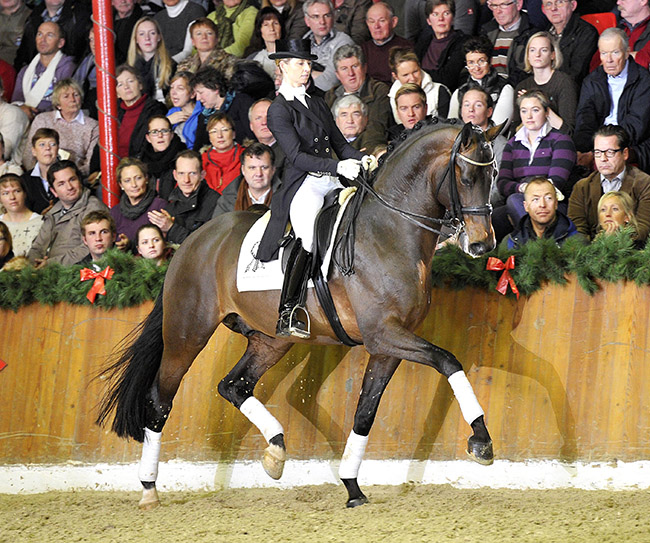 Bordeaux – competing himself and siring winners – available in Australia from International Horse Breeders. Check out the large range of top European bloodlines, including many new young stallions, available now! – www.ihb.com.au
Bordeaux – competing himself and siring winners – available in Australia from International Horse Breeders. Check out the large range of top European bloodlines, including many new young stallions, available now! – www.ihb.com.au






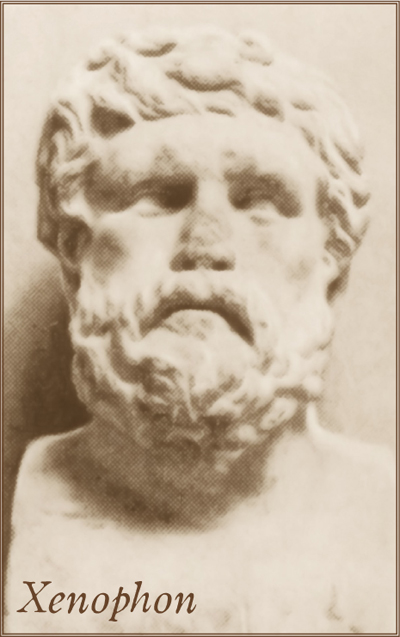
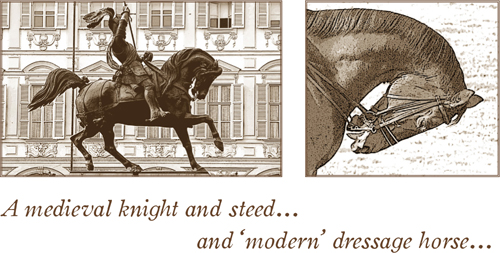
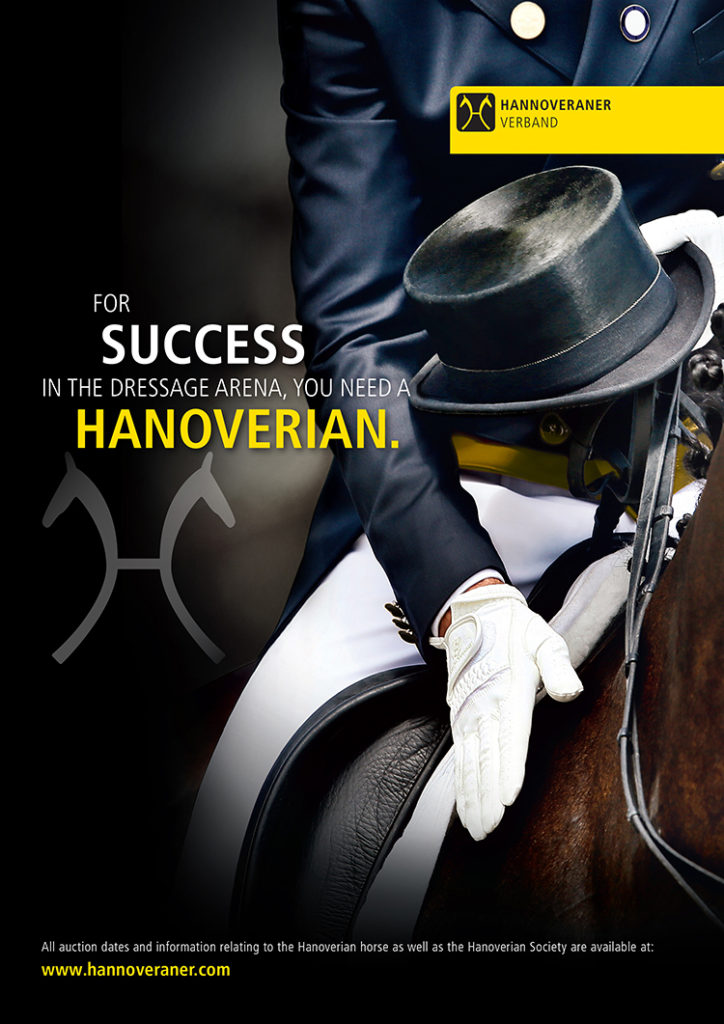
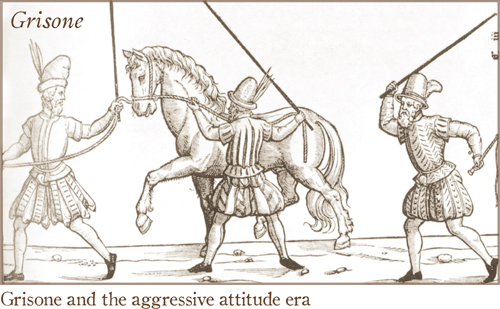
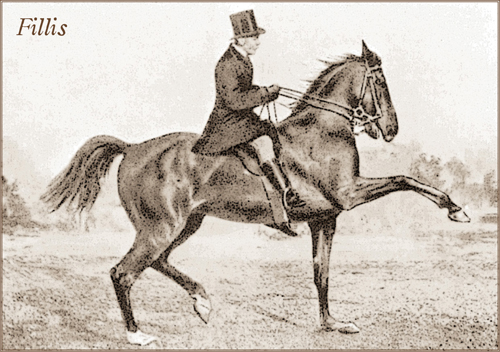
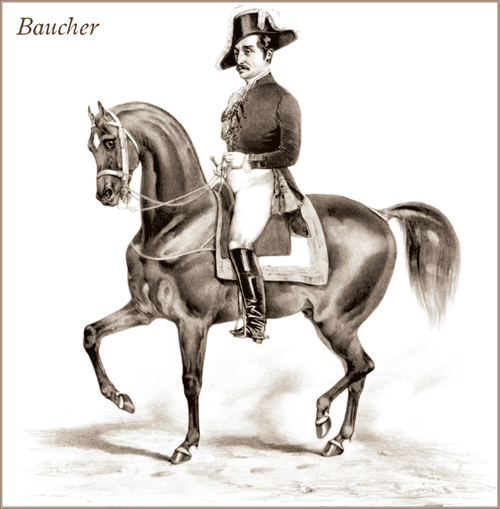
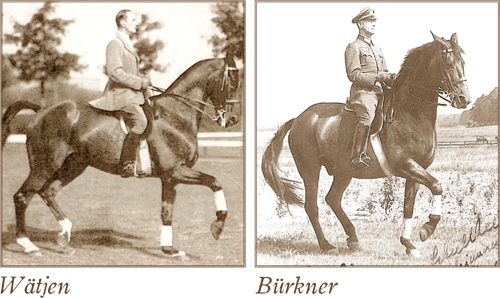
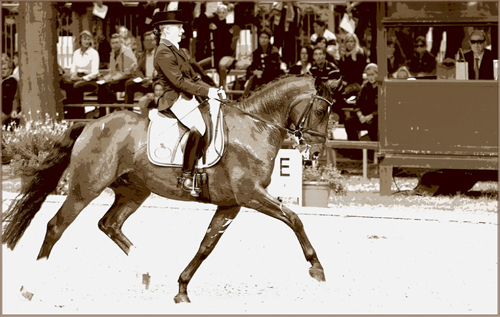
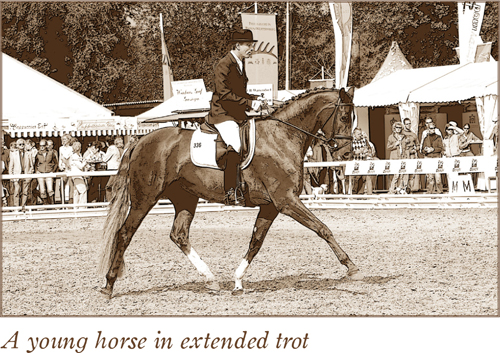

Great article, I know many that should read this article. The problem is money too, they want to sell the horses quickly. In Mexico they also have the dancing horses that are trained in all the gates almost at ones and at a very young age.
For a good history of classical training read Dressage: The Art of Classical Riding by Sylvia Loch.
I believe the quote on the Versailles manege is probably better translated as “where art ends, brutality begins”. DeKunfy had it on his arena entrance as well.
For some interesting work on how to progressively develop a horse I STRONGLY recommend investigating the works of Philippe Karl. Sylvia Loch is also very interesting Stephanie! 🙂
Very interesting read! MTPJ should be spelled metatarsophalangeal joint
For a good classical training you need time. And that is what the most riders not gives to themselves and their horses.
The BEST article I have read to date on the correct dressage training methods and why they work.
This article is very well researched and for me the statistics relating to the longevity and fitness of the average cavalry horse compared to the average competition horse say it all. For 30 years I have given similar lectures up and down the country to prove how correct classical schooling developed and blossomed – but the facts I did not know were those veterinary findings at the end. They say everything I have tried to say throughout my riding, writing and teaching career which is only what the horses themselves have told me.
My 15 hand Oldenburg x mare is now 17, I bred & trained her myself, and from age four to 7 she was ridden like a hunter, with a long swinging back and light rein, she gradually developed self carriage, and has a beautiful expression when I ask for it, but my point is, it was not forced, and she has never had a day of lameness, which I think is in part, because she developed her musculature in the most natural way she could, I had people telling me to collect her from practically the day she was first ridden, but I would not do it, as I believed she would develop with work & time..and she did.
Very interesting and informative article, should be required reading.
Wonderful article! Through years of working with horses to optimize their performance through bodywork and gymnasticizing,, I have often thought of the phrase “Richtig reiten reicht….- riding correctly is enough.” We (bodyworkers, rehab specialists) often deal with problems brought about by incorrect riding.
The HDV12 was the basis for today’s FN guidelines and everyone interested in biomechanically correct training should read it.
The HDV12/1937 is now available in English, published by Xenophon Press. http://shop.xenophonpress.com/H-DV-12-German-Cavalry-Manual-Training-Horse-Rider-ADVANCE-7112.htm
Straightness needs to be at the beginning not the end of the list
Well, actually, I think classical training is more similar to what I see in the Lippizaners and they continue to be sound to a relatively old age. Considering that they are also technically warmbloods, I am totally shocked by the early mortality described for Warmblood dressage horses in this article. Particularly as Warmbloods in Europe are only ridden seriously after they are 6 years old!!!! The photographs all show riders leaning back on their reins with tight caveson bridles. Not a happy picture or concept.
Sorry but the “poor piaffe” showed here is wrong chhosen. The picture used show a horse doing “passage”. The body of the horse doesn’t move in the same way at passage than at piaffe – we can’t compare these 2 pictures. Be more scientific if you want to convince people.
Loved this read. I’m always encouraged to stick to what I believe, when it’s backed up by such learned studies and information.
Surely the horses welfare must always come first in all areas of his life.
I found the link to the Xenophon press with the HVD training steps did not produce anything. if anyone has an up to date location where I could download this, I would most appreciate it.
Hi Carolin, try this:
https://xenophon-press.myshopify.com/products/h-dv-12-german-cavalry-manual-training-horse-rider